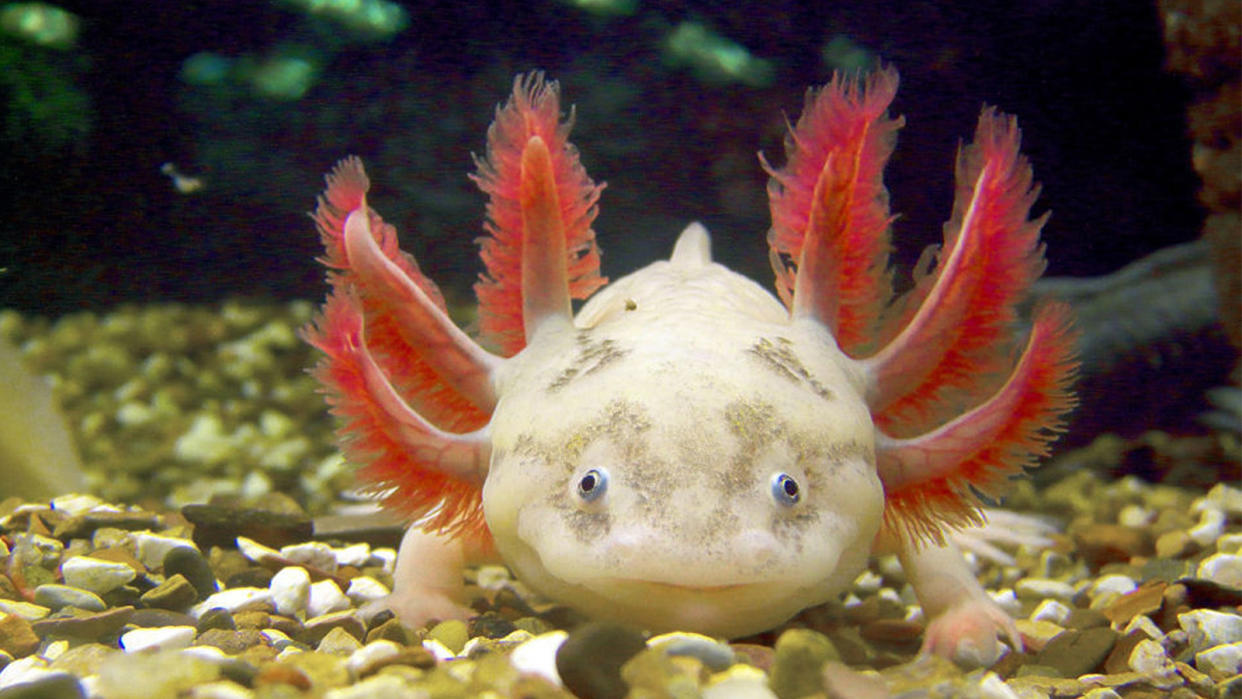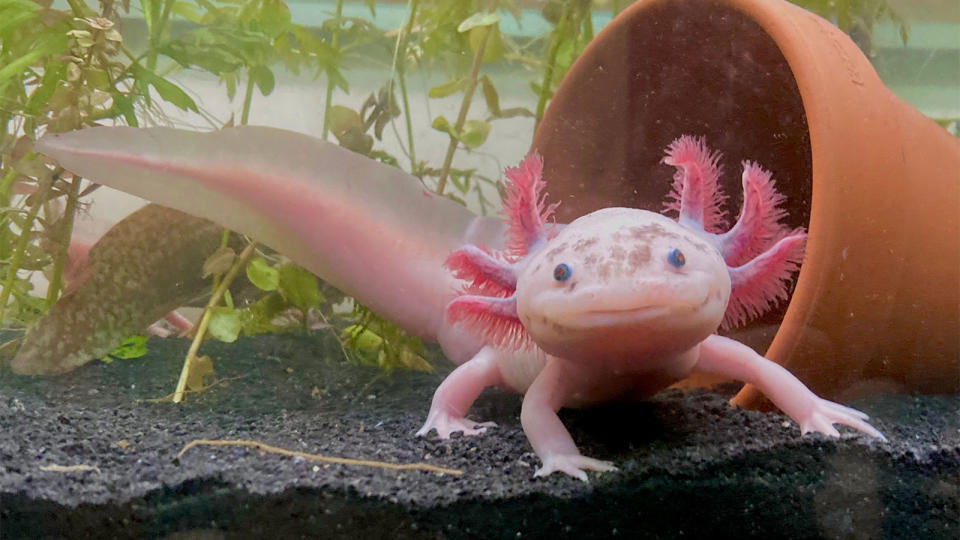Where Do Axolotls Live and Why Do They Look So Strange?

- Oops!Something went wrong.Please try again later.
The axolotl (Ambystoma mexicanum) fell into mythology centuries ago; the Aztecs believed that the first axolotl appeared in the lake system around modern day Mexico City when the powerful underworld god Xolotl transformed himself into a small, feathery amphibian to escape capture.
Among the first modern zoo animals, 34 axolotls were brought from Mexico (along with three deer and three wild dogs) to the "Jardin zoologique d'acclimatation" in Paris in 1864. But where do axolotls live today, and why do they look so alien to us?
Where Do Axolotls Live?
Axolotls are a large, threatened species of salamander that live in fresh water — specifically in Lake Xochimilco in the southern part of Mexico City. Also, while they're sometimes called "Mexican walking fish," they're amphibians, not fish at all.
What Do Axolotls Look Like?
In the wild they are most often dark brown or black with speckles, but leucitic or albino variants are common, and you often see them as pets.
With their round heads and permanently smiling faces, wild axolotls are cute (it's one of the reasons they do well in the pet trade). One reason for the cuteness overload is neoteny, which is the retention of juvenile features throughout adult life.
For instance, although adult axolotls also have functional lungs like other amphibians and can breathe through their skin, they have big, fluffy external gills — something other amphibians don't keep after babyhood.
They have small, delicate webbed feet and a long, tadpole-like tail crested with a translucent fin because they don't have to rely on their webbed feet and legs for land travel, but they have to be able to move through the water like a big tadpole.
Stable Habitat, Stable Features
Scientists think they stay baby-like throughout their lifespans because, unlike other salamander species, the wild axolotl population evolved in very stable habitats. Other salamanders species, such as the tiger salamander, live in wetlands that dry up during certain parts of the year, so they have to get rid of their feathery gills and breathe through functional lungs and through their skin.
Wild axolotls evolved in a habitat with year-round water and with very few aquatic predators, so they didn't need to spend energy changing their bodies to suit their changing circumstances.

The Axolotl's Life Cycle
An axolotl's life span is about 15 years in captivity but a wild axolotl probably lives only five or six years. They reach sexual maturity at one year, and though they're solitary creatures for the most part, in February, breeding season begins and wild axolotl males begin finding females using pheromones.
When they get together, the male does a courtship dance in which he shakes his tail in her direction. After the female acquiesces, she pokes him with her nose and he deposits a sperm packet on the lake floor, which she picks up and uses to fertilize her eggs.
The female wild axolotl will lay hundreds of eggs in the weeds or around some rocks and then leave them to fend for themselves; baby axolotls receive zero parental care.
In fact, baby axolotls, hungry after hatching from their eggs, have been observed gnawing on their siblings' legs and tails for sustenance. As you'll see, this is totally fine, because the legs will just grow back later.
Pink Predators
In their home ecosystem, axolotls are — or at least used to be — top predators around the lakes, wetlands and canals of central Mexico. They're unusual among amphibians because they remain underwater for their entire lives, breathing through feathery gills, while most other salamander species walk around on land and breathe with lungs during the adult stage of life.
Although they appear unassuming, they're actually ruthless carnivores, feasting on worms, mollusks, insects, insect larvae and even small fish in the wild.
Regenerative Abilities
Part of the Aztec mythology of the axolotl centers around the fact that, like a powerful god, they are difficult to kill. An axolotl can regenerate virtually any body part it loses, no problem. While some lizards can grow back a tail, bisected flatworms can grow back their other half and starfish can regrow a limb, an axolotl can regrow practically any part of its body in a few weeks.
"Of the animals that are closest to us — the vertebrates — salamanders are the only ones that can regenerate in this way, and can heal without scars," said David Gardiner, a professor in the School of Biological Sciences at the University of California, Irvine, when we talked to him in 2019. "Other salamanders can regenerate, but axolotls do it best."
When the Europeans got wind of axolotl regeneration, axolotls went from being a zoo exhibit to one of the most important and longest self-sustaining lab animals in history.
Georges Cuvier, popularly considered the Father of Paleontology, studied axolotls in an attempt to figure out whether Carl Linnaeus was correct in categorizing the classes Amphibia and Reptilia separately. Cuvier concluded that axolotls, because they breathe through gills their entire lives, must be some sort of lizard that existed as a perpetual larva — in the words of paleontologist Stephen Jay Gould, a "sexually mature tadpole." (Cuvier was correct sometimes, but not in this case.)
Because axolotls did incredibly well in laboratory and aquarium settings, 19th-century zoologist Auguste Duméril took it upon himself to provide every lab in Europe with a supply of axolotls, which resulted in some truly horrific studies in which scientists chopped up lab axolotls just to test the limits of their regenerative powers.
Scientific Studies Surrounding Axolotls
Scientists are interested in axolotls because they hope to figure out how to one day apply its miraculous new limb regeneration abilities to the human body. Axolotls can regenerate limbs, heart tissue, eyes and even its spinal cord and parts of its brain, and make new neurons throughout their lives, which human brains do, too, although not as readily.
"These days, axolotls are hugely important model systems for our studies about regeneration," said Gardiner. "We've known for decades — centuries, even — that we can remove parts of a developing embryonic structure and the cells that are left behind will fill in, repair and regenerate that structure. But in most animals — mammals, for instance — the system sort of shuts down at the end of embryonic development. Axolotls and other salamanders seem to be able to revert back to that embryonic-like state, reaccessing the developmental program that's already there. Humans have the program, we just stop being able to access it when we're no longer an embryo. You could say we, like axolotls, have evolved the ability to regenerate just fine, but we've also evolved a mechanism that inhibits that."
It's possible to force an axolotl to metamorphose into an adult salamander without gills by injecting it with iodine or thyroxine, or by feeding it foods that are rich in iodine. However, scientists have found that after they have metamorphosed they don't easily regenerate cells.
The Dangers Facing Wild Axolotl Populations
Wild axolotls might be godlike in their evolved ability to reaccess embryonic instructions to regenerate organs and limbs — captive axolotls might even be able to endure living in a nasty 19th-century aquarium or lab, cut up into little pieces — but what they're not able to endure is their home ecosystem being overrun with introduced predators, environmental toxins and habitat loss.
The lakes in their home around ultra-urbanized Mexico City have become not only polluted by aging wastewater systems, but overrun by invasive fish species like tilapia and perch, both of which axolotls eat with gusto. All of this has left axolotls endangered.
Conservation Efforts
The Mexican government and many axolotl conservation groups all over Mexico are doing their best to save the threatened salamander species by restoring the lakes and natural habitats they live in.
One strategy is to make stationary floating island habitats for them called chinampas — rafts made of aquatic vegetation, mud and wood that were used in ancient Mesoamerican culture as floating gardens.
Hundreds of years ago when the Aztec capital of Tenochtitlan stood in the place of Mexico City, the Aztecs built and farmed on a vast network of chinampas for miles around the capital city. This system of agriculture created canals that were shallow and sheltered, and where the axolotl population thrived.
When the European conquistadors arrived in 1519, they destroyed the Aztec civilization, removed the chinampas and drained the canals and lakes.
Now, the natural habitat of the wild axolotl population is limited to Lake Xochimilco. People are working to remove the invasive species threatening the axolotls' habitat eat the axolotls and begin using chinampas-based agriculture in Lake Xochimilco because the aquatic vegetation of chinampas not only provides habitat for the axolotls, it filter toxins out of the lake water.
Ecotourism of these chinampas has assisted in funding axolotl conservation efforts.
Captive Axolotl Populations
While the wild axolotl population is not doing well, captive populations are doing great. they're the most widely distributed amphibian in the world.
Because scientists desperately want to figure out how to help you regenerate a new set of toes, millions of them live in labs around the globe — millions more, in fact, than live in the wild. And while axolotl research is important in science, captive populations of pet axolotls are also popular in Japan, a country where you can also get axolotls as a deep-fried snack in some restaurants.
Important Notes for Pet Owners
It's not legal everywhere for pet owners to keep a pet axolotl, so it's important to check your local exotic pet laws before you get one. Because they're completely aquatic, it's important to fill the tank completely with water — a 15- to 20-gallon (57- to 151-liter) tank is best.
Much like a small fish, you never pick up or handle an axolotl, and you should never house them with another pet — a fish or another axolotl — because they won't get along with anybody.
However, if you follow those few basic rules, you'll find them relatively hardy and easy to care for. Obviously, you should be very mindful of how you treat any critically endangered species.
Now That's Interesting
The axolotl genome is the second-largest of any animal yet sequenced. The lungfish genome is the largest animal genome ever sequenced.
Original article: Where Do Axolotls Live and Why Do They Look So Strange?
Copyright © 2024 HowStuffWorks, a division of InfoSpace Holdings, LLC, a System1 Company

